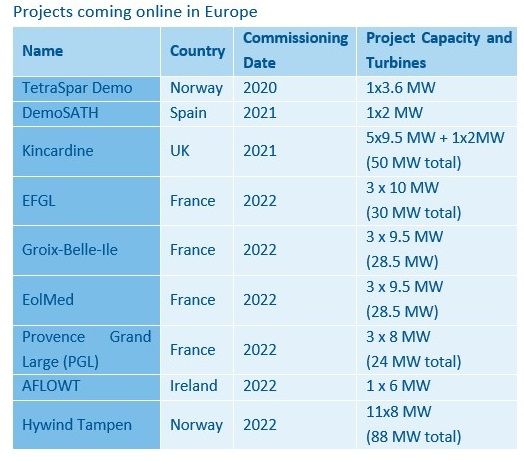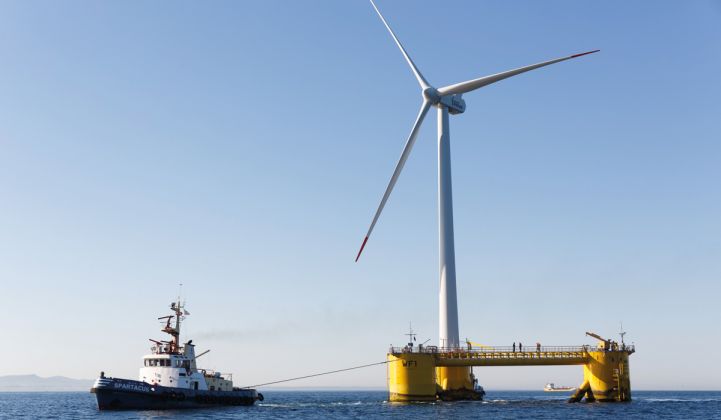French oil major Total and Macquarie’s Green Investment Group (GIG) announced plans on Tuesday to develop a 2.3-gigawatt portfolio of floating offshore wind projects in South Korea.
The pair said they will each take a 50 percent stake in five Korean projects, with an initial 500-megawatt phase to begin construction as soon as 2023. That ambitious timeline makes the projects frontrunners to be the first industrial-scale floating offshore wind farm anywhere in the world.
The global pipeline of floating wind demonstration and pilot projects has grown in recent years, with interest especially strong among oil companies. In 2022, Equinor’s Hywind Tampen demonstration project will likely become the world’s largest at 88-megawatts.
Compared to traditional bottom-fixed substructures, floating foundations allow for offshore wind development in deeper waters or in places with poor seabed conditions, potentially opening up big new markets in regions like the U.S. West Coast, Southern Europe and East Asia.
Corporate PPAs a possibility
The new joint venture of Total and Macquarie will initially cover five projects, including three off the coast of Ulsan City totaling 1.5 gigawatts and two in South Jeolla Province making up the remaining 800 megawatts. Last summer, GIG installed a floating LIDAR network off the coast in Ulsan to assess the wind resources.
“Thanks in large part to the country’s world-class shipbuilding and marine plant infrastructure, GIG and Total see significant opportunities for floating offshore wind in Korea,” said Mark Dooley, global head of GIG, in a statement.
“We are committed to working with Korean companies and the local workforce as much as possible in order to support the Korean government's Green New Deal plan, revitalize the economy and support jobs through Korea’s green transition,” added Dooley.
A spokesperson for GIG told GTM the joint venture has not yet chosen a specific technology for its floating foundations, but will “select a proven technology which can also contribute to local industry and supply chains.”
The utilities East-West Power and Korea Midland Power are provisionally agreed to act as the offtakers for the renewable energy certificates generated by the project. But the GIG spokesperson said the joint venture is not ruling out the potential for corporate offtake.
“The government is in the process of changing the regulations to allow corporate PPAs. We think this can help companies meet their commitments, including RE100 commitments, and we would like to explore the opportunities in line with the government’s plans,” the spokesperson said in an email.
Danish developer Ørsted recently signed the world's largest corporate PPA for a fixed bottom offshore wind project in Taiwanese waters.
GIG has invested in 16 offshore wind projects with a capacity of 5.5 gigawatts to date. The group was once the U.K. state-owned Green Investment Bank, prior to being sold to Australian bank Macquarie in 2017. GIG has a 25-gigawatt renewables development pipeline.
Meanwhile, Total has ramped up its own offshore wind interests this year. In March it took an 80 percent stake in the 96-megawatt Erebus floating wind project, to be developed off the coast of Wales, U.K., and it bought a 51 percent stake in the Seagreen fixed-bottom offshore wind project. The 1,140-megawatt Seagreen project is being developed by SSE Renewables and will begin generating power by the end of 2022.
Floating wind's swelling pipeline
Europe has dominated the early exploration of floating offshore wind. The 25-megawatt WindFloat Atlantic project, off the coast of Portugal, is currently the largest floating in operation, but the 50-megawatt Kincardine project in Scotland is expected to be completed this year after COVID-related delays.
In the U.S., a single-turbine demonstration project off the coast of Maine was recently acquired by RWE and Mitsubishi.

Europe has a growing list of demonstration and pilot floating offshore wind projects. (Credit: WindEurope)
By 2050, floating wind may account for one-third of Europe's offshore wind installations, a spokesperson for trade body WindEurope wrote in an email.
France plans to hold floating wind auctions in 2021 and 2022; the first auction will offer 250 megawatts of capacity with operation expected in 2026. France's second auction will offer two 250-megawatt opportunities for completion in 2027.
Meanwhile, Spanish officials are being urged to establish a 200-megawatt tender in 2021. And the U.K. government is mulling a dedicated carve-out for floating offshore wind in next year’s contracts for difference auction.




